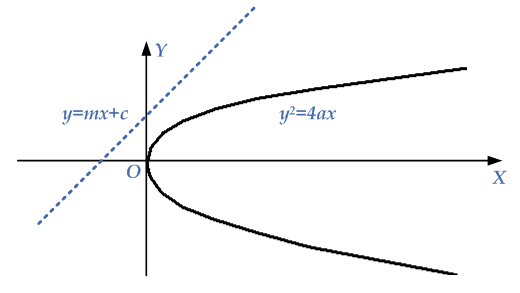No Intersection Between a Line and Parabola
The line $$y = mx + c$$ does not intersect the parabola $${y^2} = 4ax$$ if $$a < mc$$.
Consider that the standard equation of a parabola with vertex at origin $$\left( {0,0} \right)$$ can be written as
\[{y^2} = 4ax\,\,\,{\text{ – – – }}\left( {\text{i}} \right)\]
Also the equation of a line is represented by
\[y = mx + c\,\,\,{\text{ – – – }}\left( {{\text{ii}}} \right)\]
To find the point of intersection of the parabola (i) and the given line (ii), using the method of solving simultaneous equations we solve equation (i) and equation (ii), in which one equation is in quadratic form and the other is in linear form. So we take the value of $$y$$ from equation (ii) and put this value in equation (i), i.e. the equation of the parabola becomes

\[\begin{gathered} {\left( {mx + c} \right)^2} = 4ax \\ \Rightarrow {m^2}{x^2} + 2mcx + {c^2} = 4ax \\ \Rightarrow {m^2}{x^2} + 2\left( {mc – 4a} \right)x + {c^2} = 0\,\,\,{\text{ – – – }}\left( {{\text{iii}}} \right) \\ \end{gathered} \]
Since equation (iii) is a quadratic equation in $$x$$, we can solve this quadratic equation either by completing the square method or by using the quadratic formula. If equation (iii) has imaginary roots, then the line (ii) will not intersect the parabola (i), as it is clear from the given diagram.
Equation (iii) will have imaginary roots if
\[\begin{gathered} {\text{Discriminant < 0}} \\ \Rightarrow {\left( {2mc – 4a} \right)^2} – 4{m^2}{c^2} < 0 \\ \Rightarrow 4{m^2}{c^2} – 16mca + 16{a^2} – 4{m^2}{c^2} < 0 \\ \Rightarrow – 16mca + 16{a^2} < 0 \\ \Rightarrow 16{a^2} < 16mca \\ \Rightarrow \boxed{a < mc} \\ \end{gathered} \]
This is the required condition if the line does not intersect the parabola.

aisha
October 2 @ 8:44 am
can u please help me with this question:
for what values of b will the straight line y=2x+b not intersect the parabola y=x^2 +3x-5 ?